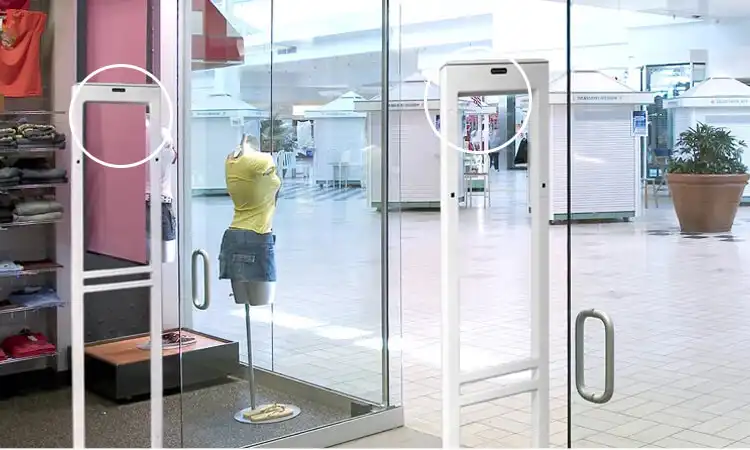Retail theft is a growing problem that costs businesses billions of dollars annually. Electronic Article Surveillance (EAS) systems have become an important tool for retailers to combat this issue. EAS systems come in different types, including Electro-Magnetic (EM), Acousto-Magnetic (AM), and Radio Frequency Identification (RFID), each offering unique features and benefits. Here, we will explore the differences between RFID vs EAS systems and help retailers understand the advantages and disadvantages of each technology, so they can make informed decisions when choosing an EAS solution for their business.
Understanding Electronic Article Surveillance (EAS) in Retail Stores
Electronic Article Surveillance (EAS) is a common theft-prevention technology used in retail stores and libraries to deter shoplifting. EAS tags can be attached to various items, including clothes, books, electronics, and other merchandise. There are several types of EAS tags available, including pins, labels, wire loops, and adhesive tabs. Once received in the store, all items are tagged with an EAS security tag, which must be deactivated at checkout to allow customers to purchase the goods legally.
EAS-enabled stores have gate readers at the entry and exit points that detect untagged or active EAS transponders, generating an electromagnetic field around the area. If tagged items move into the read field without deactivation, the readers will pick up the disturbance and raise an audible alarm to alert employees. Some stores also have cameras to monitor the gates and catch thieves in the act.
Related Articles: Basics of Electronic Article Surveillance (EAS) Systems
Types of EAS Systems to Prevent Theft
There are several types of EAS systems available, including Electro-Magnetic, Acousto-Magnetic, and RFID.
Electro-Magnetic (EM) EAS Systems for Theft Prevention
Electro-Magnetic (EM) EAS systems use tags that contain metal strips or strips of magnetic material. These tags are normally deactivated, but when they enter the low-frequency electromagnetic field created by pedestals at the store entrances and exits, their magnetic properties change, and they vibrate, emitting a harmonic sound. This disturbance triggers an alarm to alert employees that tagged merchandise is leaving the store without authorization.

EM tags can be reactivated at any time by exposing them to a strong magnetic field, which stops them from vibrating and harmonizing with other magnetic fields. This allows tagged items purchased or rented to legally exit the store without setting off an alarm.
EM EAS systems are very affordable, making them suitable for various retail and rental applications. The reusable tags can be repeatedly deactivated and reactivated as needed, providing flexibility and ease of use. This flexibility and low cost have led EM technology to become popular for:
- Libraries – Allowing easy checkout and reactivation of rented books, media, and other materials.
- DVD/Video rental stores – Enable quick checkout and return of rented DVDs, games, and other rental merchandise.
- Some clothing retailers – Permit tag reactivation for purchased or returned items.
While EM EAS systems offer advantages such as low cost and reusable tags, they can sometimes produce false alarms or be easily defeated by strong magnets. For this reason, EM technology is mainly used for securing rental items or in combination with other EAS technologies like RFID.
Acousto-Magnetic (AM) EAS Systems for Theft Prevention
Acousto-Magnetic (AM) EAS systems use ultrasonic sound waves instead of electromagnetic fields to detect tagged items. Like EM systems, AM systems have pedestals at store entrances and exits that emit frequency waves to activate tags. However, AM tags respond instead of harmonizing or vibrating by sending an ultrasonic signal back at the same frequency.

AM systems use narrowband receivers to detect the tags’ ultrasonic responses between transmissions from the pedestals. By responding with a unique ultrasonic signature, AM tags allow for selective detection – only activating an alarm for tags that have not been deactivated at checkout. This helps reduce false alarms compared to EM systems.
AM tags can be reusable plastic tags, disposable labels, or disposable tabs. They are activated by magnetizing them, which is the opposite process used for deactivating EM tags. The magnetization causes the tag to respond to the frequency transmitted from the pedestals. When checked out, AM tags are deactivated by demagnetizing them so they do not send a response signal and do not trigger an alarm.
AM EAS systems tend to have lower false alarm rates than EM systems due to their selective ultrasonic detection. However, AM tags and systems also typically cost more than EM technology. AM is a good option for retailers who want to minimize false alarms and ensure a high-security solution, even at a higher upfront cost. AM EAS is also sometimes preferred for high-value merchandise where maximum theft protection is required.
RFID EAS Systems for Theft Prevention
Radio Frequency Identification (RFID) EAS systems use radio waves instead of sound or magnetic fields to detect tagged items. RFID EAS tags contain components like wires, capacitors, and inductors that receive energy from RF waves transmitted by pedestals at store entrances and exits. The tags absorb the energy and convert it into a responsive radio signal, which wideband receivers detect as tags pass through the read field.

RFID EAS tags are available in reusable hard tags or disposable label form factors. The tag components’ number of coils and size determine the maximum read distance, typically a few feet. Larger tags with additional coils can read several feet further than smaller tags.
RFID EAS systems provide longer read ranges than acoustic or electromagnetic systems for the selective detection of tagged merchandise. RFID technology is often used for securing high-value items, controlling access to restricted areas, and preventing theft. The reusability of hard tags also makes RFID suitable for asset-tracking applications.
RFID vs EAS: What are the Key Differences?
RFID EAS systems use radio frequency identification tags that contain a unique ID number for each item. When an RFID tag is detected, this ID can be used to identify which product is passing through the EAS gates. RFID’s item-level tracking capability makes it useful for inventory management and investigating shrinkage or theft after the fact. While RFID does not directly prevent more thefts than other EAS technologies, the ability to pinpoint missing inventory can help minimize loss and expedite the recovery of stolen goods.
- RFID EAS typically has the longest read ranges of any system, able to detect tags up to several feet away. It also usually has the highest upfront costs, limiting most retailers’ use of high-value goods.
- RFID EAS provides the most comprehensive security and useful features like cycle counting, but at a premium cost. For many businesses, RFID EAS is only practical and cost-effective for use on select, high-risk merchandise.
In contrast, AM and EM EAS systems can only determine if tagged merchandise passed through the gates, not which specific items. They offer more basic theft prevention at a lower initial investment but lack the inventory tracking features of RFID.
- AM EAS uses ultrasonic sound waves and reusable/disposable tags. It tends to have shorter read ranges than RFID EAS and lower costs than RFID, but higher than EM EAS. AM EAS provides more advanced security than EM EAS but at a lower cost than RFID.
- EM EAS employs electromagnetic fields and reusable tags. It has the shortest read ranges and lowest costs of any EAS system, but the tags can also be more easily defeated. EM EAS is primarily used for basic security and preventing minor shrinkage, such as in libraries or controlling access to restricted areas.
Some key differences to consider:
- Costs: EM EAS is typically the most affordable while RFID EAS usually has the highest costs.
- Read range: RFID EAS typically has the longest range, followed by AM EAS and EM EAS.
- False alarm rates: AM EAS usually has the lowest false positive rate, followed by RFID EAS, then EM EAS.
- Item tracking: Only RFID EAS provides item-level tracking numbers for managing inventory.
- Features: RFID EAS offers the most advanced features like cycle counting. EM EAS has the fewest features for basic security.
- Suitability:
- ›EM EAS: Best for libraries and low-cost applications. Easily defeated.
- ›AM EAS: Good balance of security and affordability. Works well for general merchandise.
- ›RFID EAS: Most comprehensive security but high-cost limits use to high-value goods for most retailers.
For comprehensive EAS coverage, most retailers will use a combination of technologies, such as:
- EM or AM EAS for general merchandise, entrances, and high-traffic areas.
- RFID EAS for electronics, designer clothing, jewelry, and other high-risk/high-value goods.
- RFID EAS in combination with EM/AM at select entrances for maximum security.
- RFID tags for inventory management and cycle counting throughout the store.
Choosing between RFID vs. EAS systems for theft prevention in retail stores depends on the specific needs of each business. While RFID EAS provides item-level tracking capability, AM and EM EAS offer basic yet affordable theft prevention. Retailers should carefully evaluate each system’s advantages and disadvantages before deciding to ensure the best solution for their business.
About EAS vs RFID FAQs
-
What are the key differences between RFID and EAS systems for theft prevention?
The biggest difference between RFID and EAS systems is that RFID tags contain a unique identifying number, allowing the tags and therefore tagged items to be distinguished from one another. On the other hand, EAS systems are designed solely to trigger an alarm during the theft and have no memory or item number contained within them.
-
How do RFID tags work compared to AM and EM tags in EAS systems?
RFID tags contain a wire coil, capacitor, and inductor, which enable the tag to store energy until it reaches the frequency needed for transmission. AM EAS uses ultrasonic sound waves and reusable/disposable tags, while EM EAS employs magnetic fields and reusable tags.
-
Which type of EAS system is most commonly used in retail stores, and why?
RFID EAS is the most commonly used EAS system in retail stores due to its low installation and per-tag costs for disposable labels, which makes it a more cost-effective solution compared to Acousto-Magnetic (AM) or Electro-Magnetic (EM) EAS systems.
-
How do the costs of RFID vs EAS systems compare, and what factors should be considered when evaluating cost-effectiveness?
RFID systems generally have higher upfront costs than AM or EM systems but offer more advanced features. Retailers should consider their specific needs and requirements when evaluating cost-effectiveness.
-
What are the advantages and disadvantages of using RFID vs. AM or EM systems for preventing theft?
RFID EAS provides item-level tracking capability, while AM and EM EAS offers basic yet affordable theft prevention. However, AM and EM EAS may not work as well on liquids and metals.
-
What types of merchandise are best suited for RFID vs. AM or EM tags in EAS systems?
RFID EAS is best suited for high-risk/high-value merchandise like electronics, designer clothing, and jewelry. AM and EM EAS are better suited for general merchandise and high-traffic areas.
-
How can retailers choose the right EAS system for their specific needs and requirements?
When choosing an EAS system, retailers should consider several factors, including cost, capabilities, and requirements. A multi-technology approach is typically the most comprehensive but requires careful consideration of the advantages and disadvantages of each technology.








